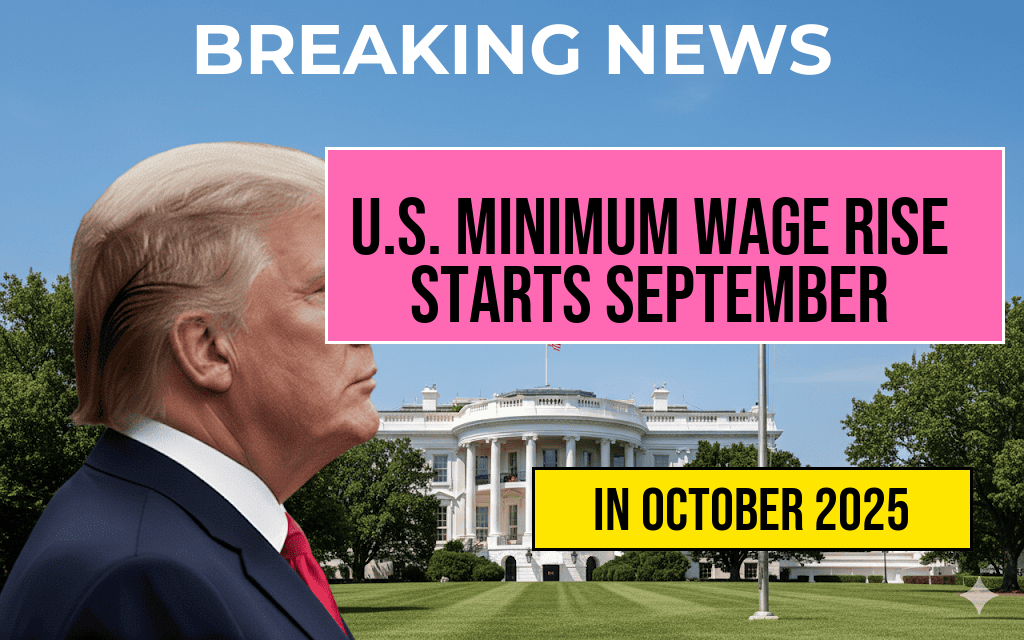The United States will see a significant update to its minimum wage standards starting September 30, 2025, with new hourly rates set across various states and jurisdictions. This adjustment reflects ongoing efforts to keep wages aligned with inflation and economic conditions, ensuring workers earn a fairer share of the country’s economic growth. While some states are implementing increases above the federal minimum, others are maintaining or gradually raising their standards based on regional economic considerations. This comprehensive update impacts millions of workers, from retail associates and healthcare aides to hospitality staff and beyond. Employers and employees alike are preparing for the changes, which aim to provide improved living standards while posing logistical considerations for payroll management. Below, a detailed list of the new hourly rates and contextual insights into this nationwide policy shift are provided.
Context and Background of the Minimum Wage Update
The minimum wage in the United States is shaped by a complex interplay of federal, state, and local laws. As of 2025, the federal minimum wage remains at $7.25 per hour, unchanged since 2009. However, many states and cities have enacted their own higher standards, reflecting regional economic conditions and political priorities. Recent legislative and ballot initiatives have driven increases in several jurisdictions, often tying wage adjustments to inflation or cost-of-living metrics.
The scheduled increase effective September 30, 2025, is part of a broader trend toward establishing a more equitable wage floor across the country. It also responds to ongoing debates about income inequality and the need for living wages. According to the U.S. Department of Labor, the upcoming changes will impact approximately 20 million workers nationwide, many of whom rely on minimum wage employment as their primary income source. For additional background on minimum wage policies, visit Wikipedia’s page on U.S. minimum wage.
State-by-State Overview of New Hourly Rates
| State | New Minimum Wage |
|---|---|
| California | $16.00 |
| New York | $15.75 (New York City and Westchester, Long Island) |
| Florida | $12.50 |
| Texas | $11.00 |
| Illinois | $14.00 |
| Washington | $15.74 |
| Massachusetts | $15.00 |
| Oregon | $15.45 |
| Colorado | $13.65 |
| Arizona | $13.85 |
Note that several states have scheduled further increases beyond 2025, driven by legislative mandates or voter-approved initiatives. For instance, California’s rate is among the highest nationally, reflecting the state’s cost-of-living adjustments, while Texas and Florida maintain lower thresholds aligned with regional economic conditions.
Key Factors Influencing the Wage Changes
Economic Inflation and Cost of Living
Many jurisdictions have increased wages based on inflation indices. As the Consumer Price Index (CPI) continues to rise, lawmakers aim to prevent minimum wages from falling behind the cost of essentials like housing, healthcare, and transportation. For example, California’s $16.00 rate is designed to offer workers a better buffer against rising living expenses in one of the country’s most expensive markets.
Political and Social Movements
Labor advocates have long championed higher minimum wages to address income disparities. Several ballot measures and legislative bills have accelerated wage hikes nationwide, especially in urban centers. The push for a $15 minimum wage at the federal level has influenced many states to adopt higher thresholds, although federal legislation remains stalled in Congress.
Regional Economic Conditions
States with robust economies and higher productivity levels tend to set higher minimum wages. Conversely, regions with lower median incomes and economic growth may opt for more modest increases. The variance across states reflects these differing regional contexts, balancing economic sustainability with worker protections.
Implications for Employers and Workers
- Employers should review payroll systems to ensure compliance with the new rates by September 30, 2025. This may involve updating salary structures, adjusting budgets, and communicating changes to staff.
- Workers can anticipate increased earnings, which may influence labor supply, hours worked, and employment decisions. For many, the raise will provide relief from rising living costs and improve financial stability.
- Small businesses may face challenges managing higher wage costs, especially in sectors heavily reliant on minimum wage labor. Some jurisdictions offer support programs or phased implementation pathways to mitigate adjustment burdens.
Looking Ahead
The upcoming minimum wage adjustments mark a critical step in ongoing efforts to modernize wage standards across the United States. While federal legislation continues to debate broader reforms, state and local governments are increasingly taking the lead in setting higher minimum wages tailored to their unique economic landscapes. Stakeholders are advised to monitor official updates and prepare for compliance ahead of the September 30, 2025, deadline. For more detailed insights into ongoing minimum wage policies and their economic impacts, reputable sources such as Forbes and the U.S. Bureau of Labor Statistics provide comprehensive analysis.
Frequently Asked Questions
What is the effective date of the new minimum wage rates?
The new minimum wage rates will take effect on September 30, 2025.
Which states are affected by the minimum wage increase?
The increase applies to all U.S. states that have scheduled changes, with specific hourly rates listed for each state in the full list.
How will the new hourly rates impact employers and employees?
The updated wages will ensure fair compensation for workers and may lead to adjustments in business payroll expenses across affected regions.
Are there any exceptions or special considerations in the new minimum wage rates?
Yes, some states or localities may have exceptions, exemptions, or different rates based on industry, employment type, or company size. Refer to the specific list for details.
Where can I find the complete list of new hourly rates for each state?
The full list of updated rates is provided in the article, detailing the state-by-state changes effective from September 30, 2025.

Leave a Reply